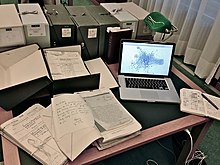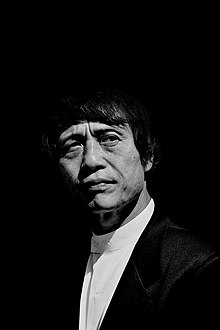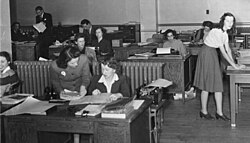Autodidacticism
Autodidacticism (also autodidactism) or self-education (also self-learning, self-study and self-teaching) is the practice of education without the guidance of schoolmasters (i.e., teachers, professors, institutions).
Overview
[edit]| Part of a series on |
| Reading |
|---|
 |
Autodidacts are self-taught[1] humans who learn a subject-of-study's aboutness through self-study.[2][3] This educative praxis (process) may involve, complement, or be an alternative to formal education. Formal education itself may have a hidden curriculum that requires self-study for the uninitiated.
Generally, autodidacts are individuals who choose the subject they will study, their studying material, and the studying rhythm and time. Autodidacts may or may not have formal education, and their study may be either a complement or an alternative to formal education. Many notable contributions have been made by autodidacts.
The self-learning curriculum is infinite. One may seek out alternative pathways in education and use these to gain competency; self-study may meet some prerequisite-curricula criteria for experiential education or apprenticeship.
Self-education[4] techniques used in self-study can include reading educational books or websites,[5] watching educational videos and listening to educational audio recordings, or by visiting infoshops. One uses some space as a learning space, where one uses critical thinking to develop study skills within the broader learning environment until they've reached an academic comfort zone.
Etymology
[edit]The term has its roots in the Ancient Greek words αὐτός (autós, lit. 'self') and διδακτικός (didaktikos, lit. 'teaching'). The related term didacticism defines an artistic philosophy of education.
Terminology
[edit]Various terms are used to describe self-education. One such is heutagogy, coined in 2000 by Stewart Hase and Chris Kenyon of Southern Cross University in Australia; others are self-directed learning and self-determined learning. In the heutagogy paradigm, a learner should be at the centre of their own learning.[6] A truly self-determined learning approach also sees the heutagogic learner exploring different approaches to knowledge in order to learn; there is an element of experimentation underpinned by a personal curiosity.[7]
Andragogy "strive[s] for autonomy and self-direction in learning", while Heutagogy "identif[ies] the potential to learn from novel experiences as a matter of course [...] manage their own learning".[8] Ubuntugogy is a type of cosmopolitanism that has a collectivist ethics of awareness concerning the African diaspora.[9][10]
Modern era
[edit]| Part of the Politics series on |
| Students' rights |
|---|
| Part of a series on |
| Research |
|---|
 |
| Philosophy portal |
| Part of a series on |
| Library and information science |
|---|
 |
Autodidacticism is sometimes a complement of modern formal education.[11] As a complement to formal education, students would be encouraged to do more independent work.[12] The Industrial Revolution created a new situation for self-directed learners.[citation needed]
Before the twentieth century, only a small minority of people received an advanced academic education. As stated by Joseph Whitworth in his influential report on industry dated from 1853, literacy rates were higher in the United States.[ambiguous] However, even in the U.S., most children were not completing high school. High school education was necessary to become a teacher. In modern times, a larger percentage of those completing high school also attended college, usually to pursue a professional degree, such as law or medicine, or a divinity degree.[13]
Collegiate teaching was based on the classics (Latin, philosophy, ancient history, theology) until the early nineteenth century. There were few if any institutions of higher learning offering studies in engineering or science before 1800. Institutions such as the Royal Society did much to promote scientific learning, including public lectures. In England, there were also itinerant lecturers offering their service, typically for a fee.[14]
Prior to the nineteenth century, there were many important inventors working as millwrights or mechanics who, typically, had received an elementary education and served an apprenticeship.[13] Mechanics, instrument makers and surveyors had various mathematics training. James Watt was a surveyor and instrument maker and is described as being "largely self-educated".[15] Watt, like some other autodidacts of the time, became a Fellow of the Royal Society and a member of the Lunar Society. In the eighteenth century these societies often gave public lectures and were instrumental in teaching chemistry and other sciences with industrial applications which were neglected by traditional universities. Academies also arose to provide scientific and technical training.
Years of schooling in the United States began to increase sharply in the early twentieth century. This phenomenon was seemingly related to increasing mechanization displacing child labor. The automated glass bottle-making machine is said to have done more for education than child labor laws because boys were no longer needed to assist.[16] However, the number of boys employed in this particular industry was not that large; it was mechanization in several sectors of industry that displaced child labor toward education. For males in the U.S. born 1886–90, years of school averaged 7.86, while for those born in 1926–30, years of school averaged 11.46.[17]
One of the most recent trends in education is that the classroom environment should cater towards students' individual needs, goals, and interests. This model adopts the idea of inquiry-based learning where students are presented with scenarios to identify their own research, questions and knowledge regarding the area. As a form of discovery learning, students in today's classrooms are being provided with more opportunity to "experience and interact" with knowledge, which has its roots in autodidacticism.
Successful self-teaching can require self-discipline and reflective capability. Some research suggests that the ability to regulate one's own learning may need to be modeled to some students so that they become active learners, while others learn dynamically via a process outside conscious control.[18] To interact with the environment, a framework has been identified to determine the components of any learning system: a reward function, incremental action value functions and action selection methods.[19] Rewards work best in motivating learning when they are specifically chosen on an individual student basis. New knowledge must be incorporated into previously existing information as its value is to be assessed. Ultimately, these scaffolding techniques, as described by Vygotsky (1978) and problem solving methods are a result of dynamic decision making.
In his book Deschooling Society, philosopher Ivan Illich strongly criticized 20th-century educational culture and the institutionalization of knowledge and learning - arguing that institutional schooling as such is an irretrievably flawed model of education - advocating instead ad-hoc co-operative networks through which autodidacts could find others interested in teaching themselves a given skill or about a given topic, supporting one another by pooling resources, materials, and knowledge.[20]
Secular and modern societies have given foundations for new systems of education and new kinds of autodidacts. As Internet access has become more widespread the World Wide Web (explored using search engines such as Google) in general, and websites such as Wikipedia (including parts of it that were included in a book or referenced in a reading list), YouTube, Udemy, Udacity and Khan Academy in particular, have developed as learning centers for many people to actively and freely learn together. Organizations like The Alliance for Self-Directed Education (ASDE) have been formed to publicize and provide guidance for self-directed education.[21] Entrepreneurs like Henry Ford, Steve Jobs, and Bill Gates are considered influential self-teachers.[22]
History
[edit]| Part of a series on |
| The Self |
|---|
| Constructs |
| Theories |
| Processes |
| Value judgment |
| As applied to activities |
| Interpersonal |
| Social |
| Politics |
The first philosophical claim supporting an autodidactic program to the study of nature and God was in the philosophical novel Hayy ibn Yaqdhan (Alive son of the Vigilant), whose titular hero is considered the archetypal autodidact.[23] The story is a medieval autodidactic utopia, a philosophical treatise in a literary form, which was written by the Andalusian philosopher Ibn Tufail in the 1160s in Marrakesh. It is a story about a feral boy, an autodidact prodigy who masters nature through instruments and reason, discovers laws of nature by practical exploration and experiments, and gains summum bonum through a mystical mediation and communion with God. The hero rises from his initial state of tabula rasa to a mystical or direct experience of God after passing through the necessary natural experiences. The focal point of the story is that human reason, unaided by society and its conventions or by religion, can achieve scientific knowledge, preparing the way to the mystical or highest form of human knowledge.
Commonly translated as "The Self-Taught Philosopher" or "The Improvement of Human Reason", Ibn-Tufayl's story Hayy Ibn-Yaqzan inspired debates about autodidacticism in a range of historical fields from classical Islamic philosophy through Renaissance humanism and the European Enlightenment. In his book Reading Hayy Ibn-Yaqzan: a Cross-Cultural History of Autodidacticism, Avner Ben-Zaken showed how the text traveled from late medieval Andalusia to early modern Europe and demonstrated the intricate ways in which autodidacticism was contested in and adapted to diverse cultural settings.[23]
Autodidacticism apparently intertwined with struggles over Sufism in twelfth-century Marrakesh; controversies about the role of philosophy in pedagogy in fourteenth-century Barcelona; quarrels concerning astrology in Renaissance Florence in which Pico della Mirandola pleads for autodidacticism against the strong authority of intellectual establishment notions of predestination; and debates pertaining to experimentalism in seventeenth-century Oxford. Pleas for autodidacticism echoed not only within close philosophical discussions; they surfaced in struggles for control between individuals and establishments.[23]
In the story of Black American self-education, Heather Andrea Williams presents a historical account to examine Black American's relationship to literacy during slavery, the Civil War and the first decades of freedom.[24] Many of the personal accounts tell of individuals who have had to teach themselves due to racial discrimination in education.
In architecture
[edit]
Many successful and influential architects, such as Mies van der Rohe, Frank Lloyd Wright, Violet-Le-Duc, Tadao Ando were self-taught.
There are very few countries allowing autodidacticism in architecture today. The practice of architecture or the use of the title "architect", are now protected in most countries.
Self-taught architects have generally studied and qualified in other fields such as engineering or arts and crafts. Jean Prouvé was first a structural engineer. Le Corbusier had an academic qualification in decorative arts. Tadao Ando started his career as a draftsman, and Eileen Gray studied fine arts.
When a political state starts to implement restrictions on the profession, there are issues related to the rights of established self-taught architects. In most countries the legislation includes a grandfather clause, authorising established self-taught architects to continue practicing. In the UK, the legislation[25] allowed self-trained architects with two years of experience to register. In France,[26] it allowed self-trained architects with five years of experience to register. In Belgium,[27] the law allowed experienced self-trained architects in practice to register. In Italy,[28] it allowed self-trained architects with 10 years of experience to register. In The Netherlands, the "wet op de architectentitel van 7 juli 1987" along with additional procedures, allowed architects with 10 years of experience and architects aged 40 years old or over, with 5 years of experience, to access the register.[29]
However, other sovereign states chose to omit such a clause, and many established and competent practitioners were stripped of their professional rights.[30] In the Republic of Ireland, a group named "Architects' Alliance of Ireland" is defending the interests of long-established self-trained architects[31] who were deprived of their rights to practice as per Part 3 of the Irish Building Control Act 2007.[32]
Theoretical research such as Architecture of Change, Sustainability and Humanity in the Built Environment[33] or older studies such as Vers une Architecture from Le Corbusier describe the practice of architecture as an environment changing with new technologies, sciences, and legislation. All architects must be autodidacts to keep up to date with new standards, regulations, or methods.
Self-taught architects such as Eileen Gray, Luis Barragán, and many others, created a system where working is also learning, where self-education is associated with creativity and productivity within a working environment.
While he was primarily interested in naval architecture, William Francis Gibbs learned his profession through his own study of battleships and ocean liners. Through his life he could be seen examining and changing the designs of ships that were already built, that is, until he started his firm Gibbs and Cox.
Predictors
[edit]Openness is the largest predictor of self-directed learning out of the Big Five personality traits, though, in a study, personality only explained 10% of the variance in self-directed learning.[34]: 642
Future role
[edit]The role of self-directed learning continues to be investigated in learning approaches, along with other important goals of education, such as content knowledge, epistemic practices and collaboration.[35] As colleges and universities offer distance learning degree programs and secondary schools provide cyber school options for K–12 students, technology provides numerous resources that enable individuals to have a self-directed learning experience. Several studies show these programs function most effectively when the "teacher" or facilitator is a full owner of virtual space to encourage a broad range of experiences to come together in an online format.[36] This allows self-directed learning to encompass both a chosen path of information inquiry, self-regulation methods and reflective discussion among experts as well as novices in a given area. Furthermore, massive open online courses (MOOCs) make autodidacticism easier and thus more common.
A 2016 Stack Overflow poll[37] reported that due to the rise of autodidacticism, 69.1% of software developers appear to be self-taught.
Notable individuals
[edit]Some notable autodidacts can be broadly grouped in the following interdisciplinary areas:
- Artists and authors
- Actors, musicians, and other artists
- Architects
- Engineers and inventors
- Scientists, historians, and educators
See also
[edit]- Academic conference
- Analytical skill
- Anti-intellectualism
- Body of knowledge
- Critical thinking
- Criticism of schooling
- Course (education)
- Cryptanalysis
- Curriculum studies
- Democratic education
- Democratization of knowledge
- Do it yourself
- Distance education
- Extracurricular activity
- Handbibliothek des allgemeinen und praktischen Wissens
- Hermeneutics of suspicion
- Independent study
- Individualism
- Informal learning
- Intellectual need
- Intelligence
- Learner autonomy
- Learning
- Liberation psychology
- Lifelong learning
- List of self-managed social centers
- Metacognition
- Open-source curriculum
- Pedagogy
- Personal development
- Polymath
- Procedural knowledge
- Reading (process)
- Rhizome (philosophy)
- Scholar
- Self awareness
- Self-experimentation
- Subject (documents)
- Tutorial
- Unschooling
References
[edit]- ^ "autodidact". Merriam-Webster Dictionary. Merriam-Webster, Inc. 2024. Retrieved 10 April 2024.
a self-taught person
- ^ "autodidact". Dictionary.com. Dictionary.com, LLC. 2024. Retrieved 10 April 2024.
a person who has learned a subject without the benefit of a teacher or formal education; a self-taught person.
- ^ "Autodidact". Cambridge Dictionary. Cambridge University Press & Assessment. 2024. Retrieved 10 April 2024.
a person who teaches himself or herself, rather than being taught by a teacher
- ^ "self-educated". Cambridge Dictionary. Cambridge University Press & Assessment. 2024. Retrieved 10 April 2024.
A self-educated person has obtained knowledge or skills by themselves rather than being taught by other people
- ^ "self-educated". The Britannica Dictionary. Encyclopædia Britannica, Inc. 2024. Retrieved 10 April 2024.
educated by your own efforts (such as by reading books) rather than in a school
- ^ Samantha Chapnick & Jimm Meloy (2005). "From Andragogy to Heutagogy". Renaissance elearning: creating dramatic and unconventional learning experiences. Essential resources for training and HR professionals. John Wiley and Sons. pp. 36–37. ISBN 9780787971472.
- ^ Hase Stewart and Chris Kenyon. Self-Determined Learning : Heutagogy in Action. Bloomsbury Academic 2015.
- ^ "Pedagogy, Andragogy, & Heutagogy". Center for Online Learning, Research and Service. University of Illinois Springfield. Retrieved 10 April 2024.
- ^ Bangura, A. K. (2005). "Ubuntugogy: An African Educational Paradigm That Transcends Pedagogy, Andragogy, Ergonagy And Heutagogy". Journal of Third World Studies. 22 (2): 13–53. JSTOR 45198556. Retrieved 10 April 2024.
[T]he essence of ubuntugogy is that it is imperative and urgent for African educators to be concerned about broader education as well as training and to be concerned about approaches to learning and teaching which are undergirded by humanity or fellow feeling toward others.
- ^ van der Walt, J. L. (2010). "'Ubuntugogy' for the 21st Century". Journal of Third World Studies. 27 (2): 249–266. JSTOR 45194719. Retrieved 11 April 2024.
Ubuntu rejects this modernistic and atomistic individualism since it overemphasizes the seemingly solitary aspects of human existence at the expense of the communal aspects and interests. It also rejects Western-style collectivism which views society as a collection of separately existing and detached individuals or small groups. Ubuntu views the individual in terms of his or her relationship with others; individuals only exist only in and through their relationships and bonds with others.
- ^ "University lecturers do not guide their students' learning to the same extent; they do not organise their students' private study (no more set homework!); nor do they filter knowledge for you in the same way. There are two reasons for this. The first reason is that you are expected to be independent, capable of organising your life, your time, your studies and your learning, so that when you graduate you are able to function successfully in your chosen profession". Extract from: The student's guide to learning at university, by Geoffrey Cooper, published in 2003 Australia by TheHumanities.com, ISBN 1-86335-510-3
- ^ J. Scott Armstrong (2012). "Natural Learning in Higher Education". Encyclopedia of the Sciences of Learning. Archived from the original on 28 October 2012.
- ^ a b Thomson, Ross (2009). Structures of Change in the Mechanical Age: Technological Invention in the United States 1790–1865. Baltimore, MD: The Johns Hopkins University Press. ISBN 978-0-8018-9141-0.
- ^ Musson; Robinson (1969). Science and Technology in the Industrial Revolution. University of Toronto Press. ISBN 9780802016379.
- ^ Robinson, Eric; McKie, Doublas. Partners in Science: Letters of James Watt and Joseph Black. Cambridge, Massachusetts. p. 4.
- ^ Jr, Quentin R. Skrabec (4 May 2012). The 100 Most Significant Events in American Business: An Encyclopedia. ABC-CLIO. ISBN 978-0-313-39862-9. Archived from the original on 30 March 2017. Retrieved 4 February 2013.
- ^ Two Centuries of American Macroeconomic Growth From Exploration of Resource Abundance to Knowledge Driven Development, pp 44 Archived 23 July 2012 at the Wayback Machine
- ^ Iran-Nejad, Asghar; Brad Chissom (1992). "Contributions of Active and Dynamic Self-Regulation to Learning". Innovative Higher Education. 17 (2): 125. doi:10.1007/bf00917134. S2CID 143153340.
- ^ Arentze, Theo; Harry Timmermans (2003). "Modeling learning and adaptation processes in activity-travel choice: A framework and numerical experiment". Transportation. 30 (1): 37. doi:10.1023/A:1021290725727. S2CID 142721970. Archived from the original on 14 August 2021. Retrieved 25 October 2020.
- ^ Illich, Ivan (1995) [1971]. Deschooling Society. London: Marion Boyars Publishers.
- ^ "About the Alliance". Alliance for Self-Directed Education. Archived from the original on 27 April 2021. Retrieved 27 April 2021.
- ^ Berger, Rod. "The Rise Of The Autodidactic Millennial As Today's Entrepreneur". Forbes. Retrieved 27 May 2024.
- ^ a b c Ben-Zaken, Avner (2010). Reading Ḥayy Ibn-Yaqẓan: A Cross-Cultural History of Autodidacticism. Baltimore: Johns Hopkins University Press. ISBN 978-0-8018-9739-9. Archived from the original on 14 August 2021. Retrieved 25 October 2020.
- ^ Williams, H.A. (2005). Self-taught: Black American Education in slavery and freedom. University of North Carolina Press. ISBN 9780807829202.
- ^ Architects (Registration) Act 1931 Archived 3 December 2016 at the Wayback Machine (UK)
- ^ Loi n°77-2 du 3 janvier 1977 sur l'architecture Archived 25 March 2016 at the Wayback Machine (Architects Act in France)
- ^ Loi du 20 fevrier 1939 Archived 26 December 2010 at the Wayback Machine (Architects Act in Belgium)
- ^ legge 24 June 1923 No. 1395 Archived 4 March 2016 at the Wayback Machine (Architects Act in Italy)
- ^ Refer to document on the Dutch Registration System drafted after a meeting between the General Secretary and Hans Groenevald, Director of the Stichting Bureau Architectenreglster, (SBA) in the Hague on 1 October 1993. 1 October 1993 is a significant date because on that day the protection of the title "architect" came into force in the Netherlands.
- ^ Refer to the example of the Republic of Ireland, where hundreds of professionally trained architects oppose new legislation that would prevent them from practicing. See Parliamentary records for more information.
- ^ You can access more information from AAoI website Archived 21 May 2013 at the Wayback Machine
- ^ For more information, you can access the full text from the Irish Building Control Act 2007 Archived 15 June 2013 at the Wayback Machine
- ^ Architecture of Change, Sustainability and Humanity in the Built Environment, Editors: Kristin Feireiss, Lukas Feireiss, ISBN 978-3-89955-211-9.
- ^ Cazan, Ana-Maria; Schiopca, Bianca-Andreea (22 April 2014). "Self-directed Learning, Personality Traits and Academic Achievement". Procedia - Social and Behavioral Sciences. 127: 640–644. doi:10.1016/j.sbspro.2014.03.327. ISSN 1877-0428.
- ^ Hmelo-Silver, C.E.; R.G. Duncan; C.A Chinn (2007). "Scaffolding and achievement in problem-based and inquiry learning: A response to Krischner, Sweller and Clark". Educational Psychologist. 42 (2): 99. doi:10.1080/00461520701263368. S2CID 1360735.
- ^ Barab, S.A.; J.G. MaKinster; J.A. Moore; D.J. Cunningham (2001). "Designing and Building an online-community: The struggle to support sociability in the inquiry learning forum". Educational Technology Research and Development. 49 (4): 71. doi:10.1007/bf02504948. S2CID 17614349.
- ^ "Stack Overflow Developer Survey 2016". Archived from the original on 20 February 2017. Retrieved 16 November 2016.
Further reading
[edit]- Bach, James Marcus (11 October 2011). Secrets of a Buccaneer-Scholar: Self-Education and the Pursuit of Passion. Scribner. ISBN 978-1-4391-0908-3.
- Blaschke, L. M. (2012). "Heutagogy and lifelong learning: A review of heutagogical practice and self-determined learning". The International Review of Research in Open and Distributed Learning. 13 (1): 56–71. doi:10.19173/irrodl.v13i1.1076.
- Brown, Resa Steindel (28 January 2007). The Call to Brilliance: A True Story to Inspire Parents and Educators. Fredric Pr. ISBN 978-0-9778369-0-1.
- Cameron, Brent (4 November 2005). SelfDesign: Nurturing Genius Through Natural Learning. Sentient Publications. ISBN 978-1-59181-044-5.
- Hailey, Kendall (1 January 1989). The Day I Became an Autodidact and the Advice, Adventures, and Acrimonies That Befell Me Thereafter. Delta. ISBN 978-0440550136.
- Hase, Stewart; Kenyon, Chris (January 2000). "From Andragogy to Heutagogy". Original UltiBASE Publication. Southern Cross University. Retrieved 10 April 2024.
- Hase, Stewart; Kenyon, Chris (2019) [July 2007]. "Heutagogy: A Child of Complexity Theory". Complicity. 4 (1): 111–118. doi:10.29173/cmplct8766. Retrieved 10 April 2024.
- Llewellyn, Grace (29 September 2021). The Teenage Liberation Handbook: How to Quit School and Get a Real Life and Education. Lowry House Publishers. ISBN 978-0962959196.
- McAuliffe, M.; Hargreaves, D.; Winter, A.; Chadwick, G. (11 November 2015) [2009]. "Does Pedagogy Still Rule?". Australasian Journal of Engineering Education. 15 (1): 13–18. doi:10.1080/22054952.2009.11464018. Retrieved 10 April 2024.
- "Open Syllabus: Mapping the college curriculum across 20.9 million syllabi". Open Syllabus. Retrieved 10 April 2024.
Non-profit archive [...] provides top-down views of the curriculum across thousands of schools to support curricular innovation, lifelong learning, and student success.
- Rancière, Jacques (1 July 1991). The Ignorant Schoolmaster: Five Lessons in Intellectual Emancipation. Stanford University Press. ISBN 978-0804719698.
- Reimer, Everett (1 January 1971). School is Dead: An Essay on Alternatives in Education. Penguin. ISBN 978-0140801699.
- Solomon, Joan (28 August 2003). The Passion to Learn: An Inquiry into Autodidactism. Routledge. ISBN 978-0415304184.
- Stark, Kio (10 April 2013). Don't Go Back to School: A Handbook for Learning Anything. Kio Stark. ISBN 978-0988949003.[unreliable source?]
External links
[edit] Quotations related to Autodidacticism at Wikiquote
Quotations related to Autodidacticism at Wikiquote
- African-American society
- African Americans and education
- Alternative education
- Applied learning
- Area studies
- Black studies
- Cybernetics
- Education activism
- Education theory
- Education in Poland during World War II
- Education museums in the United States
- Espionage
- History of education in the United States
- Information sensitivity
- Learning
- Learning methods
- Learning to read
- Lyceum movement
- Methodology
- Open content
- Pedagogical movements and theories
- Philosophical methodology
- Philosophy of education
- Play (activity)
- Pre-emancipation African-American history
- Problem solving methods
- Research methods
- Sampling (statistics)
- School desegregation pioneers
- Science experiments
- Self-care
- Teaching
- Underground education
- United States education law
- WikiLeaks

